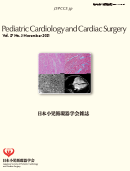Volume 37, Issue 3
Displaying 1-17 of 17 articles from this issue
- |<
- <
- 1
- >
- >|
Preface
-
2021Volume 37Issue 3 Pages 163-164
Published: November 01, 2021
Released on J-STAGE: January 08, 2022
Download PDF (160K)
Review
-
2021Volume 37Issue 3 Pages 165-172
Published: November 01, 2021
Released on J-STAGE: January 08, 2022
Download PDF (2627K) -
2021Volume 37Issue 3 Pages 173-183
Published: November 01, 2021
Released on J-STAGE: January 08, 2022
Download PDF (1759K) -
2021Volume 37Issue 3 Pages 184-192
Published: November 01, 2021
Released on J-STAGE: January 08, 2022
Download PDF (4941K) -
2021Volume 37Issue 3 Pages 193-202
Published: November 01, 2021
Released on J-STAGE: January 08, 2022
Download PDF (566K)
Original Article
-
2021Volume 37Issue 3 Pages 203-207
Published: November 01, 2021
Released on J-STAGE: January 08, 2022
Download PDF (203K) -
2021Volume 37Issue 3 Pages 208-214
Published: November 01, 2021
Released on J-STAGE: January 08, 2022
Download PDF (562K)
Case Report
-
2021Volume 37Issue 3 Pages 220-226
Published: November 01, 2021
Released on J-STAGE: January 08, 2022
Download PDF (1469K) -
2021Volume 37Issue 3 Pages 227-232
Published: November 01, 2021
Released on J-STAGE: January 08, 2022
Download PDF (1851K) -
2021Volume 37Issue 3 Pages 233-238
Published: November 01, 2021
Released on J-STAGE: January 08, 2022
Download PDF (3326K) -
2021Volume 37Issue 3 Pages 239-245
Published: November 01, 2021
Released on J-STAGE: January 08, 2022
Download PDF (1246K)
Editorial Comment
-
2021Volume 37Issue 3 Pages 215-216
Published: November 01, 2021
Released on J-STAGE: January 08, 2022
Download PDF (171K) -
2021Volume 37Issue 3 Pages 217-219
Published: November 01, 2021
Released on J-STAGE: January 08, 2022
Download PDF (855K)
-
2021Volume 37Issue 3 Pages 246-247
Published: November 01, 2021
Released on J-STAGE: January 08, 2022
Download PDF (127K) -
2021Volume 37Issue 3 Pages 248-249
Published: November 01, 2021
Released on J-STAGE: January 08, 2022
Download PDF (139K)
-
2021Volume 37Issue 3 Pages 250
Published: November 01, 2021
Released on J-STAGE: January 08, 2022
Download PDF (108K) -
2021Volume 37Issue 3 Pages 251-252
Published: November 01, 2021
Released on J-STAGE: January 08, 2022
Download PDF (173K)
- |<
- <
- 1
- >
- >|
